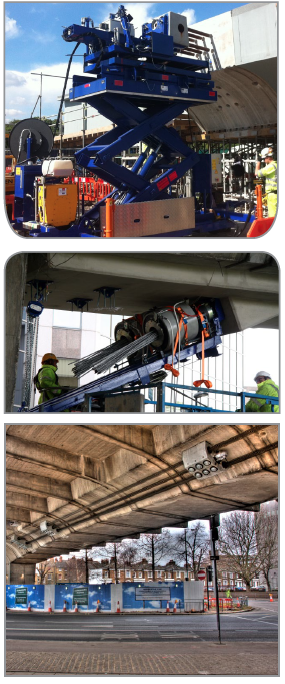Post-Tensioning, Strengthening and Concrete Repair
Client
Transport for London
Main Contractor
Costain
Value
£20 million
Works Commenced
December 2014
Works Completed
Summer 2015
Hammersmith Flyover is an elevated roadway in West London which carries the A4 dual carriageway over the central Hammersmith gyratory system. Completed in 1961, it is one of the first examples of an elevated road constructed using reinforced concrete.
The viaduct was closed for a short time in late 2011/early 2012 during a detailed emergency assessment. Freyssinet was appointed to carry out localised strengthening (‘Phase 1’) in a short time frame to allow the flyover to be fully open in time for the London Olympics in July 2012.
Having successfully completed works on Phase 1, Freyssinet was appointed again to provide further specialist repair works, including post-tensioning and strengthening to the A4 flyover in Phase 2.
The works took place in a congested urban site environment, to a very tight programme, and as a result Freyssinet was required to innovate and develop solutions in order to meet client’s key project objectives, which were summarised as:
- Minimise the disruption to traffic, local residents and businesses during the construction
- Extend the serviceable life of the structure
- Minimise whole life costs
Phase 2 required all works to be carried either from below or within the bridge box, which was located over live carriageways and pedestrian areas, as well as alongside heavily trafficked thoroughfares.
Freyssinet developed a number of different methods and applications to facilitate these requirements, most significantly the development and manufacture of three blister lifters. Each of these allowed multi-axis, three dimensional control for the placing of precast anchor blocks on the structure.
In addition, Freyssinet was able to provide its expertise for moving heavy objects throughout the internal length of the bridge and as well as providing technology that enabled the repair. The list of specialist techniques Freyssinet employed included:
- New capping and tendon anchor blisters
- 6 no new post tensioning systems each of 37 strands inside the box
- Mid span 22 strand tendons
- Additional 13 strand external and internal tendons
- Additional mid span deviators
- Hydro-demolition services to facilitate the above
- Concrete repairs
Freyssinet also provided its own access to complete the works beneath the bridge and over live traffic.
Once complete, Freyssinet was required to stress the new post-tensioning system, while at the same time destressing the existing system in place on the bridge, which had associated difficulties including the removal of the locked in forces.
Access to the internal face of the external blister was difficult, due to the need to place large components in a tight space, which included the placement of ultra-high strength concrete which could not be traditionally pumped due to the steel fibres causing irreparable damage to colloidal mixers. As a result, Freyssinet developed a completely new concrete pump from scratch. The pump effectively acted as a large scale hydraulic syringe, negating the need for significant access provision and the use of such in a sensitive environment.
The works were completed successfully to the satisfaction of the client. Freyssinet has since received innovation awards for the techniques used on the structure.
